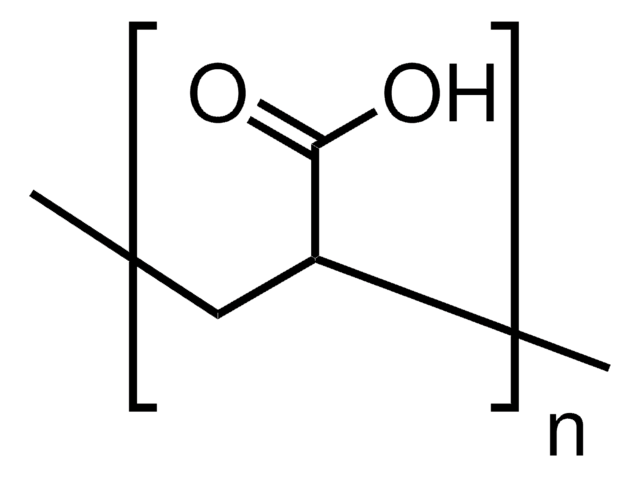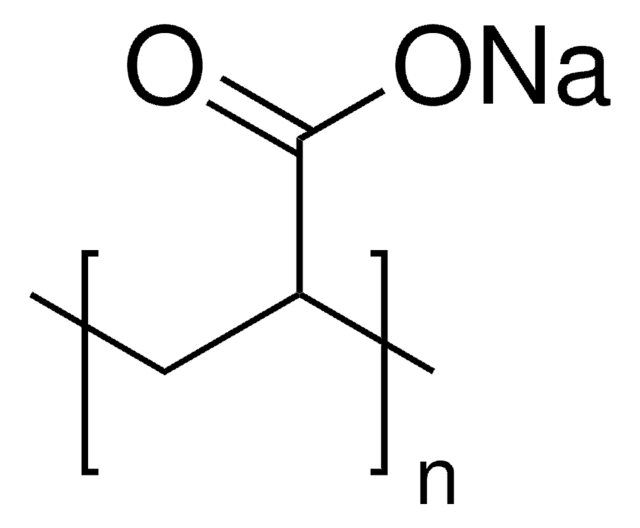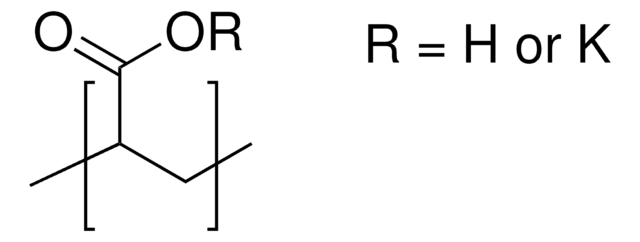306223
Poly(acrylic acid)
average Mv ~3,000,000
About This Item
Produits recommandés
Réticulation
~0.1 % cross-linked
Poids mol.
average Mv ~3,000,000
Viscosité
30,000-40,000 cP
Température de transition
Tg 106 °C
InChI
1S/C3H4O2.Na/c1-2-3(4)5;/h2H,1H2,(H,4,5);/q;+1/p-1
Clé InChI
NNMHYFLPFNGQFZ-UHFFFAOYSA-M
Vous recherchez des produits similaires ? Visite Guide de comparaison des produits
Catégories apparentées
Application
- IR and Raman investigation of some poly(acrylic) acid gels in aqueous and neutralized state: This study explores the modification of local polymeric conformation of poly(acrylic) acid (PAA), induced by hydration and neutralization with triethanolamine, using IR and Raman spectroscopy. (M Todica et al., 2015).
- Phase Behavior of Aqueous Poly(acrylic acid-g-TEMPO): Research on poly(acrylic acid) grafted with TEMPO moieties, focusing on phase separation behavior over different pH ranges, which could be relevant for creating responsive materials. (Q Fu et al., 2016).
- Synthesis and characterization of poly(glyceric acid carbonate): a degradable analogue of poly(acrylic acid): This article presents a degradable analogue to poly(acrylic acid) and compares the properties of hydrogels prepared from this new polymer with those from PAA, relevant for biomedical applications. (H Zhang et al., 2015).
- Mechanically stable thermally crosslinked poly(acrylic acid)/reduced graphene oxide aerogels: Study on enhancing the mechanical integrity of reduced graphene oxide aerogels by intermixing with thermally cross-linkable PAA, pertinent to material science. (H Ha et al., 2015).
- Polyacrylic acid polymers hydrogels intended for topical drug delivery: preparation and characterization: Investigates the bioadhesiveness of polyacrylic acid polymers in hydrogels, emphasizing their potential in designing topical drug delivery systems. (G Calixto et al., 2015).
Mention d'avertissement
Danger
Mentions de danger
Conseils de prudence
Classification des risques
Carc. 1A - Muta. 1B
Code de la classe de stockage
6.1C - Combustible acute toxic Cat.3 / toxic compounds or compounds which causing chronic effects
Classe de danger pour l'eau (WGK)
WGK 3
Point d'éclair (°F)
Not applicable
Point d'éclair (°C)
Not applicable
Certificats d'analyse (COA)
Recherchez un Certificats d'analyse (COA) en saisissant le numéro de lot du produit. Les numéros de lot figurent sur l'étiquette du produit après les mots "Lot" ou "Batch".
Déjà en possession de ce produit ?
Retrouvez la documentation relative aux produits que vous avez récemment achetés dans la Bibliothèque de documents.
Les clients ont également consulté
Notre équipe de scientifiques dispose d'une expérience dans tous les secteurs de la recherche, notamment en sciences de la vie, science des matériaux, synthèse chimique, chromatographie, analyse et dans de nombreux autres domaines..
Contacter notre Service technique



